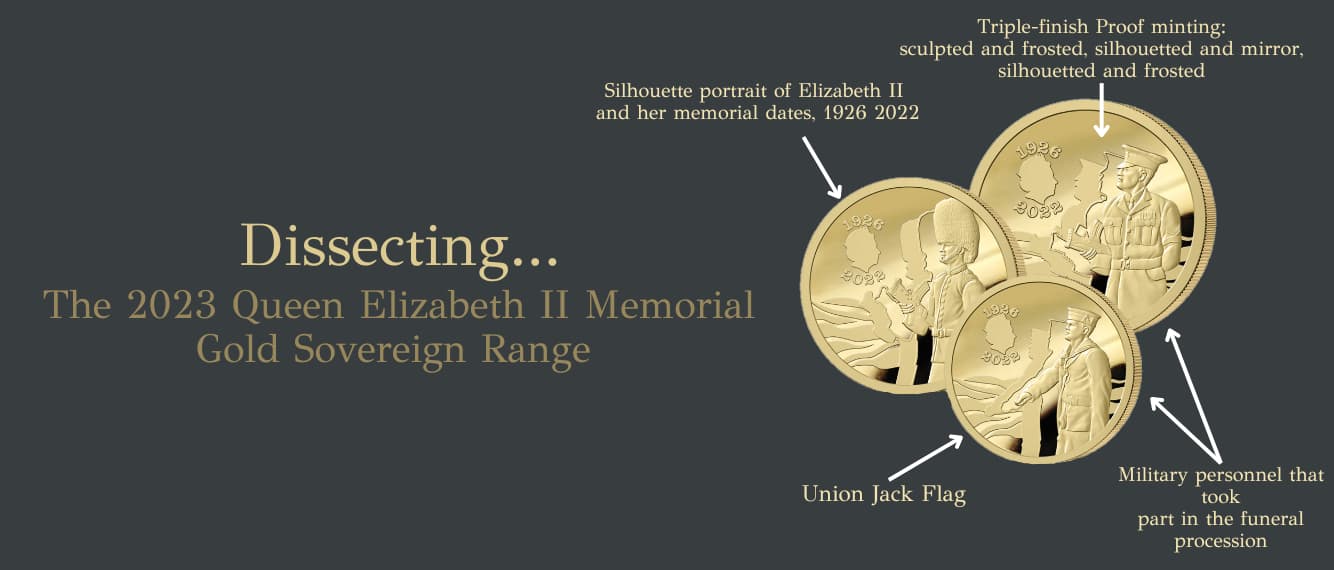
Our latest release; the 2023 Queen Elizabeth II Memorial Gold Sovereign Range, marks the first anniversary of the passing of Queen Elizabeth II with designs that recall the military procession and State funeral with which this nation paid its last respects, to our greatest ever monarch.
Each coin in this series features one of the armed services that played such an important role in the queen’s funeral procession. Here, we dissect the reverse sides of these incredible sovereigns for you…
The Quarter Sovereign
The first denomination in this Queen Elizabeth II Memorial range is the quarter sovereign. The reverse features a silhouetted row of Royal Navy seamen representing all naval personnel who took part in the queen’s funeral. Following a tradition dating back to the funeral of Queen Victoria, around 140 Royal Navy sailors pulled the gun carriage carrying the Queen’s coffin. These included personnel from the RNAS Culdrose, RNAS Yeovilton, HM Submarines, HMS Sultan and HMNB Portsmouth.
Having been founded by Henry VIII in 1546, The Royal Navy helps to ‘stabilise the seas, keeping the maritime trade that’s the lifeblood of the UK economy flowing’. As well as the Royal Marines and the Royal Fleet Auxiliary, the Royal Navy is part of His Majesty’s Naval Service. Its six major roles are to prevent conflict, provide security at sea, maintain a readiness to fight, protect the economy, provide humanitarian aid, and cement relationships with the UK’s allies.
The Half Sovereign
The next denomination, the half sovereign, features a silhouetted row of Grenadier Guardsmen, the most senior of the Foot Guards regiments, representing all those in the British Army who took part in the procession. Soldiers of the Queen’s Company, 1st Battalion of the Grenadier Guards, were given the honour of acting as the coffin’s bearer party because of their unique association with the monarch.
The British Army, a part of the British Armed Forces, was founded in 1660 under the reign of Charles II and is the UK’s land warfare force. The role of the British Army is to ‘protect the UK, prevent conflict, deal with disaster, and fight the nation’s enemies’. Queen Elizabeth II held the position of Company Commander of the Grenadier Guards’ Queen’s Company and the troops of the Household Division were responsible for guarding the Queen and her palaces during her reign.
The Sovereign
Next up, we have the sovereign, which features a silhouetted row of RAF airmen are depicted on the Sovereign. In addition to marching in the precession, the regular RAF bands provided continuous music throughout the procession, including funeral marches by Beethoven, Mendelsohn and Chopin. Big Ben tolled for the duration of the procession, which marched at 75 paces to the minute, a speed reserved for funerals.
The Royal Air Force, founded towards the end of World War I in 1918, is the first independent air force in the world, having regrouped the Royal Flying Corps and the Royal Naval Air Service. The RAF is responsible for ‘defending the skies of Britain and projecting Britain’s power and influence around the world’, with their main objectives being respond to threats, prevent conflict, watch the skies, deliver aid, work in partnership and combat cyber threats.
The Double Sovereign
Finally, one of our premium denominations, the double sovereign, features a silhouetted row of Yeomen of the Guard representing all non-military services who took part in the Funeral Procession of Elizabeth II.
The role of Yeoman of the Guard was created in 1485 during the reign of Henry VII, making them the oldest Royal bodyguards and oldest military corps still in existence in Britain. Currently there are 73 Yeoman of the Guards and they are only appointed if they are former warrant or non-commissioned officers of the British Services. The Yeoman of the Guard still wear their Tudor uniforms of red, gold and white, and now have a purely ceremonial role in many Royal events.


